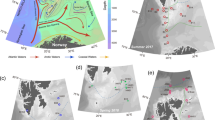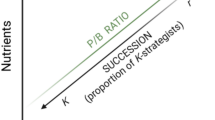Abstract
Lake Hayward is a hypersaline lake that stratifies seasonally and maintains oxygen supersaturation in its bottom water for about 6 months each year. This phenomenon was found to be the result of photosynthesis by the benthic microbial communities, composed primarily of the cyanobacteria Cyanothece spp., Spirulina sp., and Oscillatoria sp. When these communities were present and the lake was stratified, the bottom water was supersaturated with oxygen (up to 370%). During illumination, the benthic microbial communities rapidly developed very high concentrations (e.g., >500 μM) of oxygen, which then diffused into the overlying water. However, while the overlying water became supersaturated, the concentration in the water was lower than in the benthic microbial communities because (1) transport across the sediment-water interface was limited by diffusion, and (2) turbulence rapidly mixed the oxygen throughout the much larger volume of the bottom water (approximately 1.5 m deep). Thus, import of oxygen by the benthic microbial communities at night proceeded more slowly than daytime export, allowing supersaturation of the bottom water to develop.
Similar content being viewed by others
References
Archer D, Emerson S, Smith CR (1989) Direct measurement of the diffusive sublayer at the deep sea floor using oxygen microelectrodes. Nature 340:623–626
Ashton PJ, Schoeman FR (1983) Limnological studies on the Pretoria Salt, a hypersaline maar lake. Hydrobiologia 99:61–73
Bauld J (1981) Occurrence of benthic microbial mats in saline lakes. Hydrobiologia 81:87–111
Bubela B (1980) Some aspects of the interstitial water movement in simulated sedimentary systems. BMR J Aust Geol Geophys 5:257–263
Burke CM, Knott B (1989) Limnology of four groundwater-fed saline lakes in southwestern Australia. Aust J Mar Freshwater Res 40:55–68
Castenholz RW, Bauld J, Pierson BK (1991) Photosynthetic activity in modern mat-building communities. In: Schopf JW, Klein C (eds) The proterozoic biosphere: a multidisciplinary study. Cambridge University Press, New York, pp 279–285
Cohen Y, Krumbein WE, Goldberg M, Shilo M (1977) Solar Lake (Sinai). I. Physical and chemical limnology. Limnol Oceanogr 22:597–608.
Commander DP (1988) Geology and hydrogeology of the superficial formations and coastal lakes between Harvey and Leschenault inlets (Lake Clifton project). Geol Surv West Aust Prof Pap Rpt 23:37–50
De Wit R, Jonkers HM, Van Den Ende FP, Van Gemerden H (1989) In situ fluctuations of oxygen and sulfide in marine microbial sediment ecosystems. Neth J Sea Res 23:271–281
Dumont HJ (1981) Kratergöl, a deep hypersaline crater-lake in the Steppic zone of Western Anatolia (Turkey), subject to occasional limno-meteorological perturbations. Hydrobiologia 82:271–280
Galat DL, Lider EL, Vigg S, Robertson SR (1981) Limnology of a deep, North American, terminal lake, Pyramid Lake, Nevada, U.S.A. Hydrobiologia 82:281–318
Grant J, Bathmann UV, Mills EL (1986) The interaction between benthic diatom films and sediment transport. Est Coast Shelf Sci 23:225–238
Holland AF, Zingmark RG, Dean JM (1974) Quantitative evidence concerning the stabilization of sediments by marine benthic diatoms. Mar Biol 27:191–196
Jones AG, Ewing CM, Melvin MV (1981) Biotechnology of solar saltfields. Hydrobiologia 82:391–406
Jørgensen BB, Revsbech NP (1985) Diffusive boundary layers and the oxygen uptake of sediments and detritus. Limnol Oceanogr 30:111–122
Jørgensen BB, Revsbech NP, Cohen Y (1983) Photosynthesis and structure of benthic microbial mats: microelectrode and SEM studies of four cyanobacterial communities. Limnol Oceanogr 28:1075–1093
Jørgensen BB, Cohen Y, Revsbech NP (1986) Transition from anoxygenic to oxygenic photosynthesis in a Microcoleus chthonoplastes cyanobacterial mat. Appl Environ Microbiol 51:408–417
Parker BC, Simmons GM, Jr, Seaburg KG, Cathey DD, Allnutt FCT (1982) Comparative ecology of plankton communities in seven Antarctic oasis lakes. J Plankton Res 4:271–286
Revsbech NP (1989) An oxygen microsensor with a guard cathode. Limnol Oceanogr 34:474–478
Revsbech NP, Jorgensen BB (1986) Microelectrodes: their use in microbial ecology. In: Marshall KC (ed) Advances in microbioal ecology, vol. 9. Plenum Publishing, New York, pp 293–352.
Revsbech NP, Ward DM, (1983) Oxygen microelectrode that is insensitive to medium chemical composition: use in an acid microbial mat dominated by Cyanidium calderium. Appl Environ Microbiol 45:755–759
Revsbech NP, Jorgensen BB, Blackburn TH, Cohen Y (1983) Microelectrode studies of the photosynthesis and O2, H2S, and pH profiles of a microbial mat. Limnol Oceanogr 28:1062–1074
Santschi PH, Bower P, Nyffeler UP, Azevedo A, Broecker WS (1983) Estimates of the resistance to chemical transport posed by the deep-sea boundary layer. Limnol Oceanogr 28:899–912
Steane MS, Tyler PA (1982) Anomalous stratification behaviour in Lake Gordon, headwater reservoir of the lower Gordan River, Tasmania. Aust J Mar Freshwater Res 33:739–760
Weiss RF (1970) The solubility of nitrogen, oxygen, and argon in water and seawater. Deep Sea Res 17:721–735
Wetzel RG (1983) Limnology, 2nd ed., Saunders College Publishing, Philadelphia
Author information
Authors and Affiliations
Rights and permissions
About this article
Cite this article
Burke, C.M. Benthic microbial production of oxygen supersaturates the bottom water of a stratified hypersaline lake. Microb Ecol 29, 163–171 (1995). https://doi.org/10.1007/BF00167162
Received:
Revised:
Issue Date:
DOI: https://doi.org/10.1007/BF00167162




